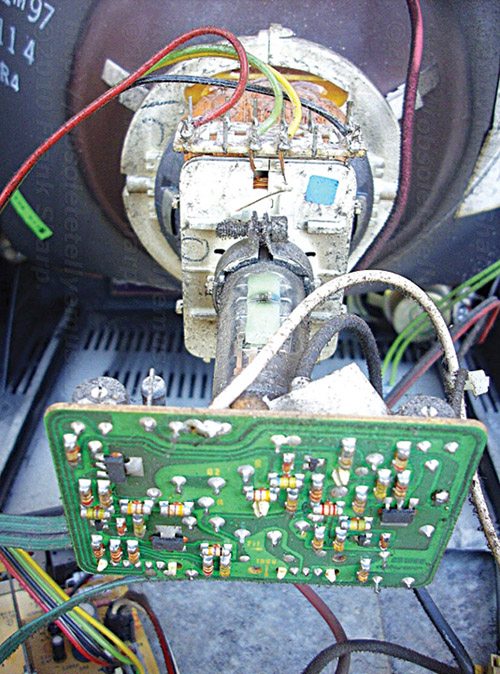When he made a public demonstration of his technological marvel, the iconoscope in Pittsburgh in 1924, he was politely asked “to spend my time on something ‘a little more useful.’” Zworykin applied for a patent for an electronic television system in 1923 but the patents were never granted. He obtained a doctorate from the University of Pittsburgh in 1926 and continued to refine his system but Westinghouse failed to weigh its worth. He joined RCA in 1929—the year he obtained his first patent for colour television.
Working on a similar system in Japan, Kenjiro Takayanagi demonstrated a 40-line television at the Hamamatsu Industrial High School on December 25, 1926. The first picture was the Japanese character for ‘I’, ‘’. This prototype is still on display at the Takayanagi Memorial Museum in Shizuoka University. The war prevented further research.
Back in Soviet Union, Léon Theremin developed a mirror drum-based television and increased its resolution from 16 lines to 32 lines. Then he invented the technique of interlacing the video signal. On May 7, 1926, as part of his thesis, he transmitted and projected near-simultaneous moving images on a 1.5-metre square screen at a scan rate of 64 lines, and by 1927 it went up to a 100 lines. This was beaten by RCA in 1931 with 120 lines.
Bell Telephone Laboratories was not too far behind. Herbert E. Ives and Frank Gray gave a spectacular exhibition of a mechanical television on April 7, 1927. The reflected-light television system had two receivers, a small one with a 5×6cm2 screen and a large one with a 61×76cm2 screen. Interestingly, monochromatic moving images also had synchronised sound, probably for the first time! Yes, sir, until then you had to keep a radio by the side to receive sound! A 50 aperture disk produced a rate of 18 frames per second transmitting the images over two paths: a wire link from Washington to New York City, and a radio link from Whippany, New Jersey. The study revealed that quality was almost equal. The then secretary of Commerce, Herbert Hoover, also participated in this telecast. Television historian Albert Abramson remarked: “It was in fact the best demonstration of a mechanical television system ever made till date. It would be several years before any other system could even begin to compare with it in picture quality.”
He was wrong. By 1927, Baird could successfully transmit a signal over 705 km of telephone line between London and Glasgow. He went onto transmit the first transatlantic television signal between London and New York, and the first shore-to-ship transmission by 1928.
Television had now reached a reasonable stage where scheduled broadcast could begin. C.F. Jenkins was authorised to transmit images from an experimental station W3XK in Wheaton, Maryland, US. On July 2, 1928, Jenkins transmitted 48-line silhouette images sometimes in halftones taken from motion picture films. Forget the exorbitant price of $85 to $135, or of constant retuning, it was sheer excitement for the folks in the late twenties to watch a blurry moving image projected onto a 15-centimetre square mirror.

In 1932, BBC inaugurated a television service. Baird had by now increased his electromechanical scan to 240 lines. Interestingly, the scenes were shot on a 35mm film, developed and then scanned while the film was still wet. On July 1930, BBC transmitted the first British television play, ‘The Man with the Flower in his Mouth.’ The screen size resembled a postcard.
But the real drama was building up elsewhere around this time and it was more exciting than any television serial.
Remember the young boy who showed his sketches to his chemistry teacher? It does seem quite unlikely that this unknown boy with little education, no money, and no equipment could steal the limelight from the greatest electrical companies in the world, but that is precisely what Farnsworth had set out to do.
Philo T. Farnsworth was born on August 19, 1906 at Indian Creek, near Beaver City, Utah. This young American farmer dreamt of a device that could project images transmitted through the air. His inspiration came while he was tilling a potato field back and forth one day in 1922. He thought of capturing the light in a jar, magnetically scan the picture into individual lines and transmit it in a series of electron beams. He would reconstruct the picture similarly.
His father advised Philo not to discuss his idea to anyone as he feared that these ideas could be pirated easily. Ideas, he reasoned, were too valuable and fragile. Leaving a legacy of only this advice, his father died of pneumonia. By 1923, the family responsibility fell on Philo’s shoulders. When asked if he planned to go back to school, he replied, “No, I can’t afford it.”
It became difficult for Philo to finance his fledgling invention. “I’m quite sure it would work. Unfortunately, the only way I can prove it is by doing it myself; but I don’t have any money.” With a little financial help from his friend George Everson, Philo continued his work on his invention.





